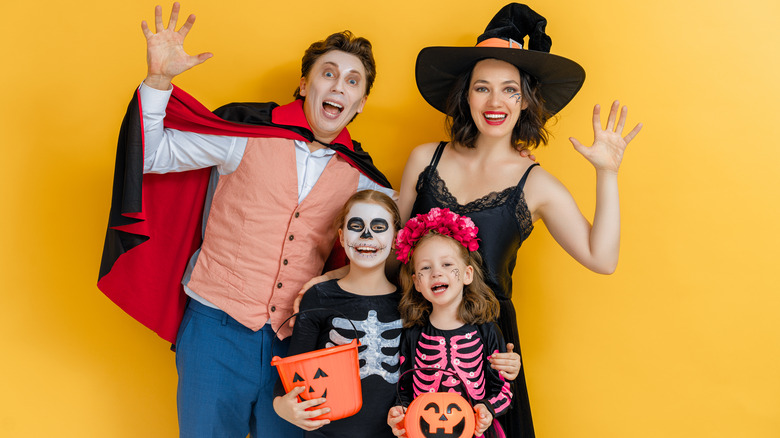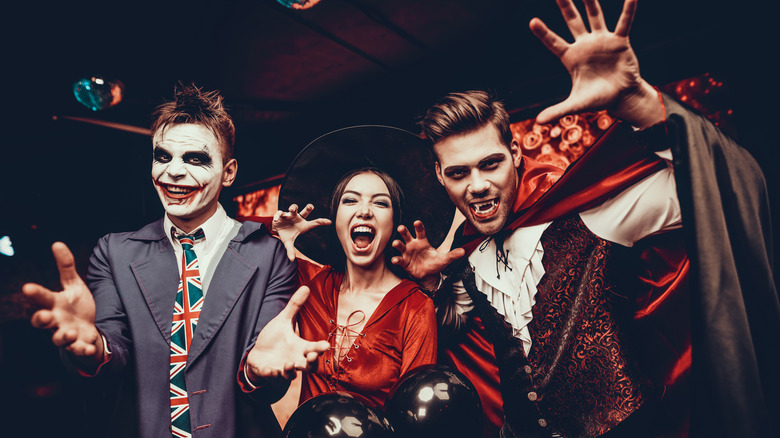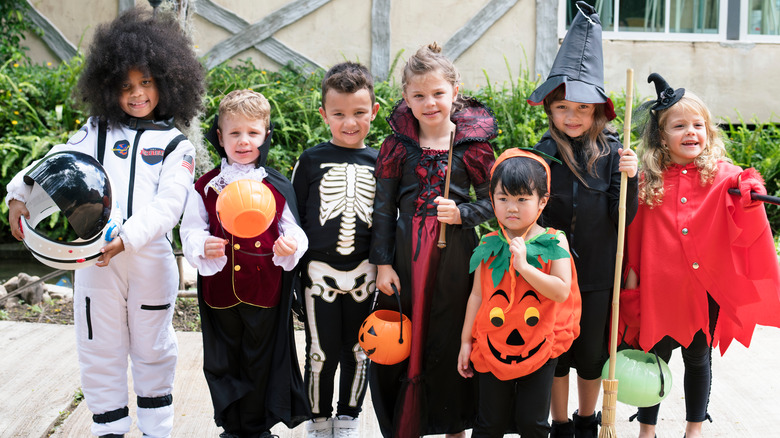Here's Why We Wear Costumes On Halloween
$3.3 billion. That's the amount of money the National Retail Federation estimates Americans will spend on Halloween costumes this year; it tops the list of Halloween spending, followed by decorations at $3.2 billion and candy at $3 billion. They've also figured out the most popular costumes: for kids, it's Spiderman; for adults, it's a witch; and for pets – because we can't leave them out — it's a pumpkin.
Maybe your costume style is over-the-top, Heidi Klum style. Klum, that queen of Halloween, has hosted a Halloween bash for decades and always dresses to impress, including the time she spent seven hours in the makeup chair to dress up as a werewolf (from Cosmopolitan). Or maybe you and your friends are planning a group costume together, or maybe you just pull something together from your closet at the last minute. Whatever your Halloween costume vibe, it can definitely be fun to dress up as someone, or something, else for the day.
But have you ever wondered about why we dress up for Halloween at all?
Halloween can be traced back to 2,000 years ago
Halloween itself can be traced back 2,000 years ago to a Celtic pagan festival called Samhain, which was held at the halfway point between the fall equinox and the winter solstice to mark the start of the "darker half of the year" (from History). During the festival, it was believed the boundary between the world of gods and spirits and the world of people came down, and people would wear costumes to confuse the spirits.
"Hiding behind their costumes, villagers often played pranks on one another, but blamed the spirits," Lesley Bannatyne, Halloween expert, told CNN Style. "Masks and cover-ups came to be seen as means to get away with things. That's continued throughout Halloween's evolution."
Dressing up in costumes in late fall continued when the Christian church established All Souls' Day / All Saints' Day by 1000 AD, celebrated at basically the same time of year as Samhain, that featured parades, bonfires, and dressing up as angels, devils, or saints (from History).
The festival came to America with Irish and Scottish immigrants, and according to fashion historian Nancy Deihl, "People in rural America really embraced its pagan roots, and the idea of it as a dark occasion, centered around death. They wore scary, frightening get-ups, which were made at home with whatever was on hand: sheets, makeup, improvised masks," (from CNN Style).
Commercial Halloween costumes have given us nearly endless options
Halloween, both how and why it's celebrated, continued to evolve over the decades, but it's never lost the costume aspect. "Halloween costumes have gone from disguises to full-on exhibitionist," fashion researcher Anna-Mari Almila explained to CNN Style.
Being able to buy already-made costumes, and not having to make them, made it possible to be just about anyone or anything for Halloween. Costume companies in the 1930s licensed pop culture characters like Snow White and Popeye to bring costumes to the masses (from Slate). After World War II, costume manufacturing really kicked into high gear, and with so many bargain priced costumes available, dressing up for Halloween has just gotten easier and easier with more and more options over the years (via Slate).
So whatever you put on this Halloween or as you admire the costumes of others, remember that you're looking at a tradition that's been 2,000 years in the making.


